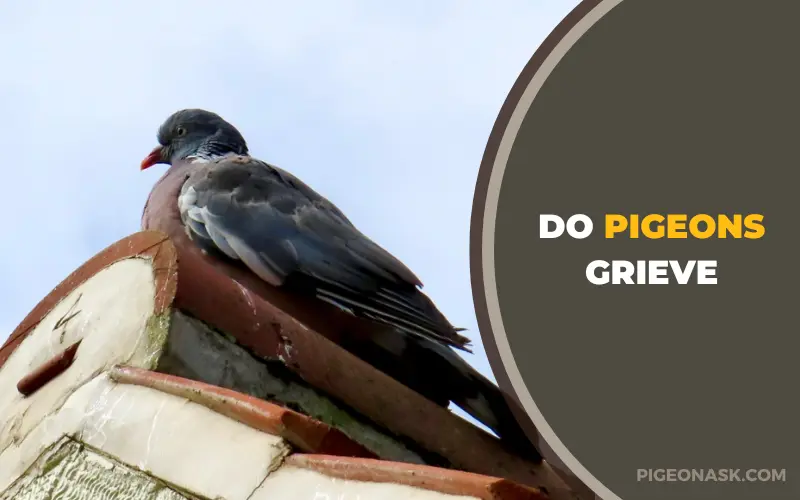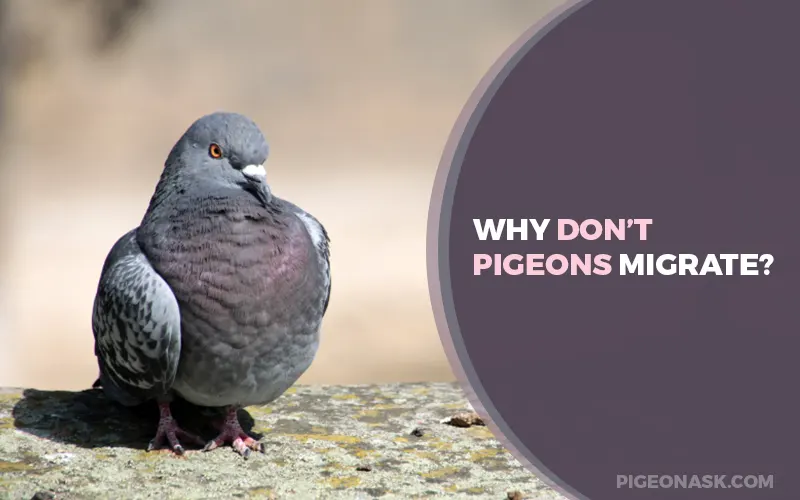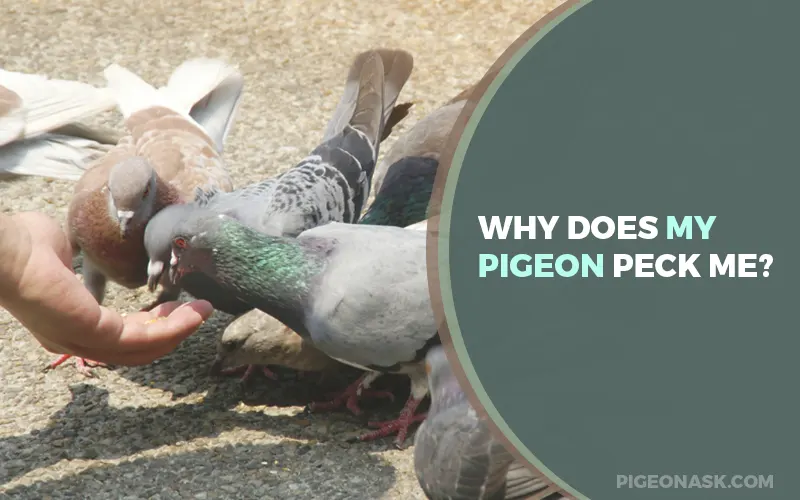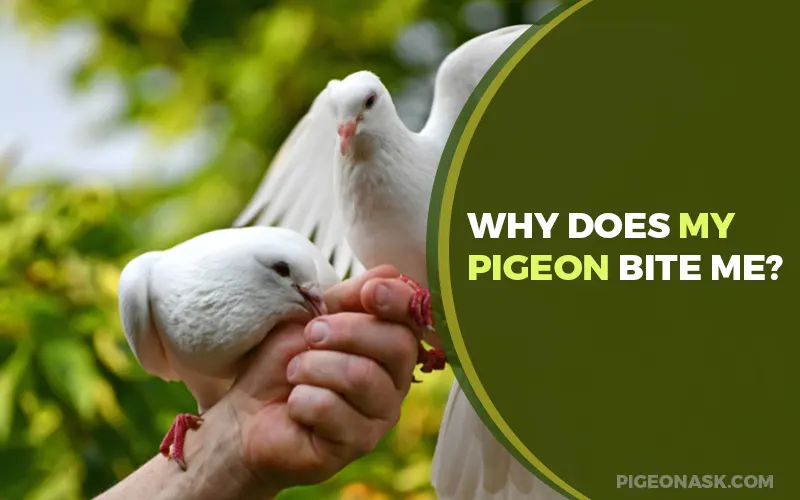Mysteries of Pigeon Behavior
Pigeons often mimic others around them and develop certain skills. They have diverse behavioral patterns, and you can learn about them here!
While you may know them as peaceful messenger birds, did you know that pigeons engage in aggressive mobbing behavior in certain situations?
Pigeons are arguably one of the most sought-after avian pets. They have some unique behavior traits, and raising them without understanding these traits is a different challenge altogether.
That’s why we recommend you learn about the behavioral facts of pigeons if you are considering raising them.
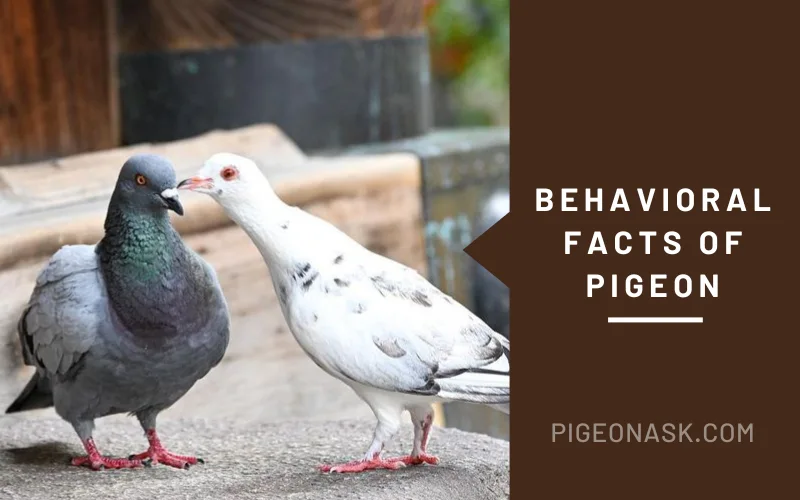
These birds behave differently based on the situation, upbringing, environmental conditions, and more. So, if you want to understand pigeons’ behavioral patterns, keep reading!
A Short Overview of Different Behavioral Traits
While there are certain behaviors that specific species show that others don’t, you will find a good number of common behaviors that actually define the personality of pigeons. The general behavioral traits consist of the following –
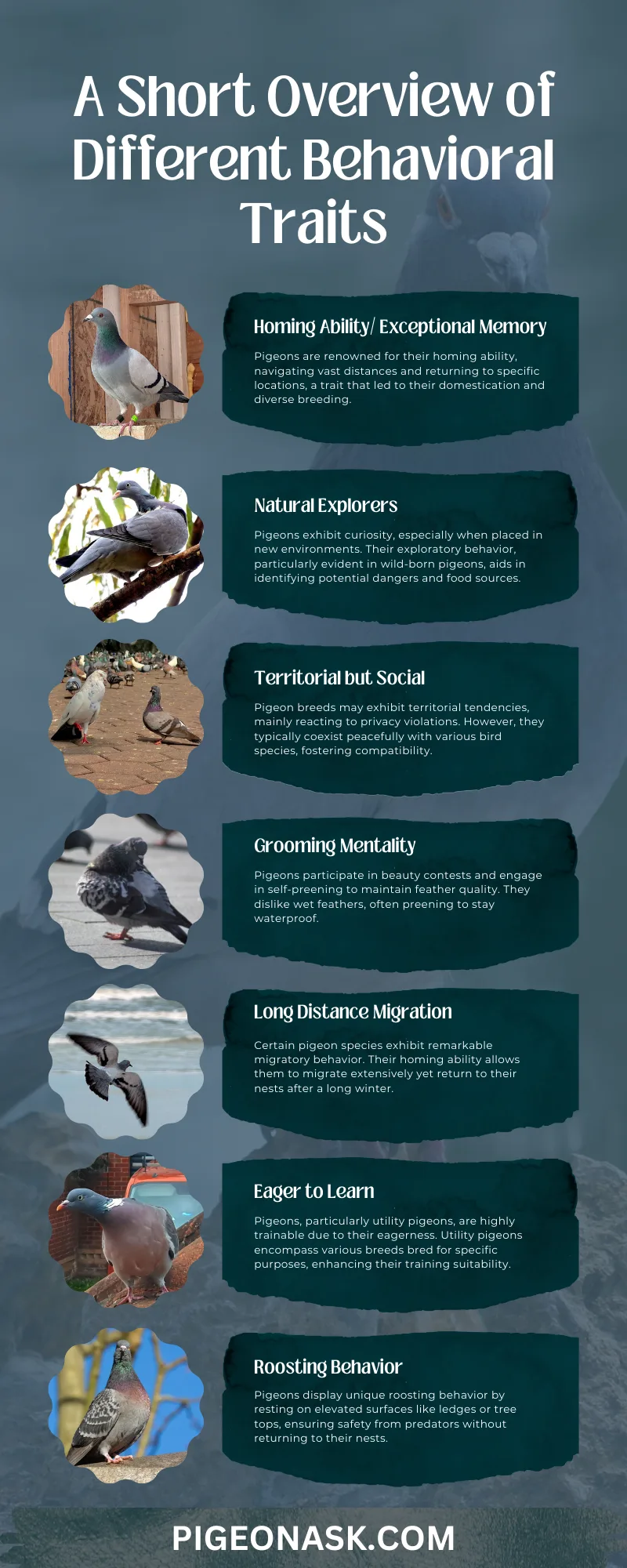
Homing Ability/ Exceptional Memory
When you think of a pigeon’s behavior, one of the first things that should come across your mind is its extraordinary ability to remember home.
These birds are able to return to a specific spot even after crossing long distances. They are able to visit their marked spots without forgetting the route and the way to get back home.
This ability made humans domesticate and breed pigeons in the first place and opened up more opportunities and reasons to breed these birds.
Natural Explorers
Pigeons are curious by nature. If you leave them in a new area, they will start to explore the surroundings almost immediately. This is highly noticeable among pigeons that are born in the wild.
Research suggests that they do this to find out potential threats and food sources around the area.
Territorial But Social
Some breeds of pigeons are highly territorial, but this doesn’t mean they are aggressive to every living thing around them. Most of the time, the aggression is situational and is triggered by privacy invasion.
They are comfortable with most bird breeds. So, if you want to raise some other birds with your pigeons, you can certainly do so.
Grooming Mentality
Pigeons are a common appearance in beauty contests, and it is not just their owners who want to make them look good.
These birds prefer preening to fix their feathers and stay waterproof even in the rainy seasons. They don’t like it when their feathers are all soggy and wet.
Long Distance Migration
There are a few species of pigeons that show incredible migratory behavior, and due to their ability to remember their homes, they can migrate a long distance and still return to their nests after a long winter.
Eager to Learn
Pigeons are one of the most eager birds on the planet, which makes training them extremely easy. Utility pigeons shine in this situation the most. They are a category of pigeons that consists of different pigeons bred for specific purposes.
Roosting Behavior
A unique behavioral pattern of pigeons is roosting. This is a form of resting those pigeons do on the high ground, like on a ledge or tree tops. Doing this allows them to rest and stay out of predator attacks without going to their nests.
Pigeon Behavioral Significance
Behavioral analysis of any kind allows us to understand an animal better so that we can create an optimal environment for it. For animals like pigeons, doing this also gives us valuable insights that can be used to improve our lives.
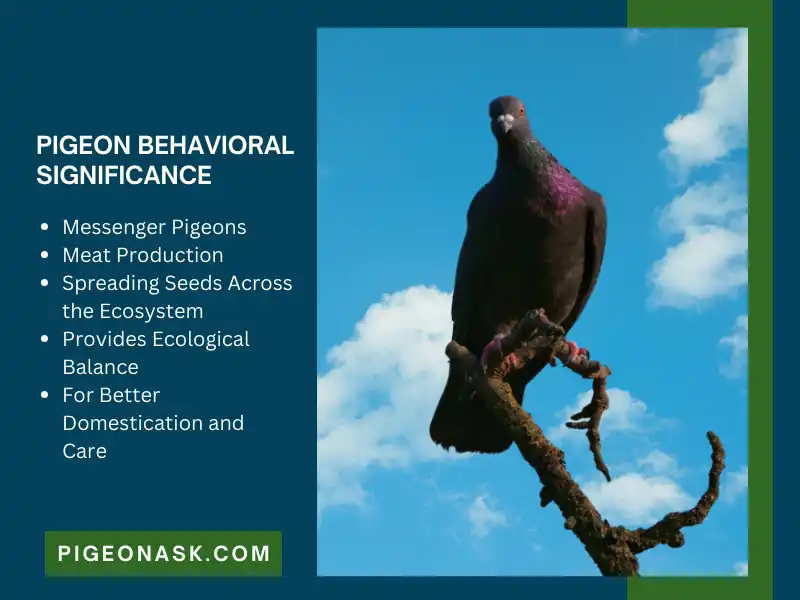
Messenger Pigeons
Nowadays, we don’t rely on pigeons for sending our messages, but back in medieval times, by monitoring their homing behavior, we were able to use them as our messengers.
Meat Production
Squab or pigeon meat is also a well-known food source for us. Pigeons bred for squab require special attention for breeding, practicing, and mating.
But we won’t be able to make the proper decisions if we don’t understand their behaviors.
Spreading Seeds Across the Ecosystem
Pigeons that are born in the wild don’t get a steady food source and have to move around to find the proper amount of food.
Similar to the pollination process conducted by bees, pigeons can carry seeds from one area to the other. This allows versatile plant growth and evolution.
Provides Ecological Balance
As mentioned before, pigeons play a role in plant growth. By monitoring their behavior pattern, we can ensure that a pigeon brings balance to the ecosystem through its feeding behavior.
They also attract predators like different types of raptors and owls. That’s why understanding their characteristics allows us to protect wildlife in a way.
For Better Domestication and Care
Finally, by analyzing their behavior, we are able to take care of them more effectively. This also allows us to breed pigeons for specific roles.
Pigeon Growing Habits: Developing Patterns and Physical Adaptations
The growth development of pigeons is quite astonishing. They also showcase different types of behavior in each step of their growth and physical adaptation.
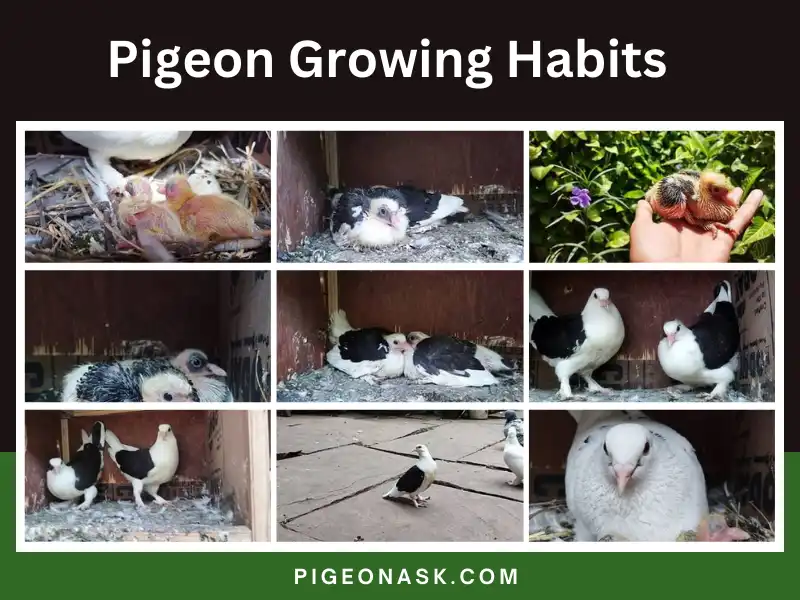
Growth and Development
A pair of pigeons will lay one or two eggs after mating, and the eggs generally hatch after 17 to 20 days of incubation.
Once that period is over, altricial pigeon chicks are born. During this time, their eyes haven’t developed yet, nor do they have their feather. They will stick to their parents, and the parents will feed the young ones for almost a month.
After a few weeks, the chicks will start to grow feathers. This growth will be very drastic.
But after they mature a little, they will grow their flight feathers, which has a relatively standard growth rate. This is called fledging behavior, and once that is over, they leave the nest.
Physical Adaptations
From being born to the end of the fledgling cycle, pigeons go through quite a few physical adaptation stages. These are:
- Developing feathers, muscles, beak and bill
- Honing their eyesight, strong ventilation system and homing capability
- Circulatory system improvement, development of reproduction organs and crops (extra food storage right above the stomach).
Behavioral Differences: Domestic Pigeons VS Wild Pigeons
At first glance, you may not notice any difference between a domestic pigeon and a wild pigeon just by looking at their appearance.
Once you start to look into their behaviors, you will see the drastic difference between domestic pigeons and wild pigeons.
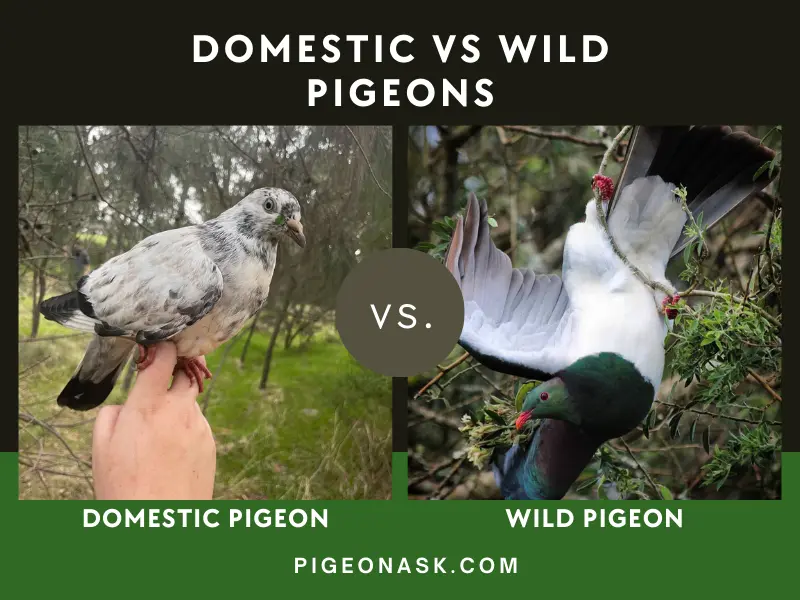
Human Interaction
Domestic pigeons will interact with humans more than wild pigeons. This is simply due to the fact that they were raised under human care and know that a human won’t hurt them.
On the other hand, while they aren’t hostile toward humans, wild pigeons don’t have the same amount of experience compared to domestic pigeons. They may identify humans as a possible threat and will be reluctant to interact at first sight.
Feeding Behavior
The feeding behavior of domestic pigeons and wild pigeons will vary as domestic pigeons are fed by humans, so they don’t actually know how to search for food or how to gather it.
But wild pigeons do. They are highly skilled foragers who are able to find food just by scouting the environment in a few minutes.
Wild pigeons eat natural food options, while domestic pigeons are known to consume bird foods and other food options for different breeding purposes along with the normal seed and grains.
Memory, Flight Pattern and Homing Ability
Wild pigeons have a better perception and homing ability than domestic pigeons. This is understandable because almost every wild pigeon gets to develop their abilities, while domestic pigeons don’t really feel the need to do so.
That doesn’t mean these pigeons won’t have superior memory and homing ability; they are just not as good as the wild ones.
The flight pattern of these two bird types also varies for the same reason.
Courtship and Mating
Most of the time, the courtship and mating for domestic pigeons are heavily influenced by humans to get specific breeds.
There is hardly any courtship involved. That is not the same for wild pigeons, and they will follow the natural order.
Migration
Domestic pigeons are given enough comfort so they won’t change their behavior during the migrating season of pigeons.
Social Behavior Differences
Most of the time, domestic pigeons are kept in pairs or with their chicks, not with the entire flock. That’s why their social behavior might be a bit lackluster compared to the wild pigeons that live in groups or search for food together.
Feeding Habits
Seeds and grains are the primary food for pigeons. They display foraging behavior and will search the ground from the sky and look for seeds and grains.
Pigeons that are living in an urban setting may display scavenging behavior and consume food scraps and bread crumbs.
In extreme cases, they may change their food habit and go for small insects. They only go for them when food source is very scarce.
Mating (Breeding) Habits and Migration Patterns
Mating habits and migration patterns vary among species, from intricate courtship displays to long-distance journeys, revealing fascinating adaptations for reproduction and survival in the natural world.
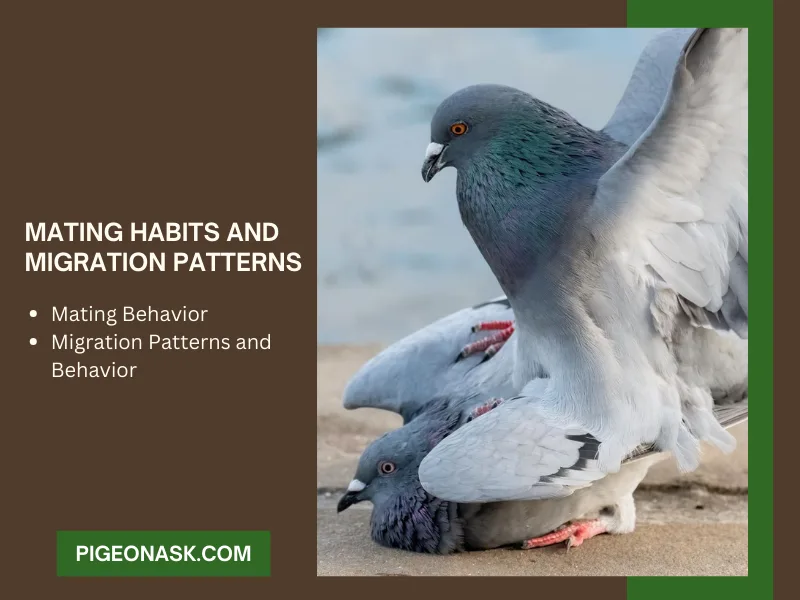
Mating Behavior
Pigeons are monogamous and will breed with their mate until one of them perishes. In a domestic setting, this can change if the partner is removed by the humans.
To attract female partners, male pigeons will go through courtship rituals. Their courtship behavior consists of skydiving, cooing, feather puffins, and head bobbing. They can mate on multiple occasions.
Once a pair mate, they will go and build their nests and start mating. Both the father and mother incubate the eggs. Mothers also feed a crop secretion called pigeon milk to the young ones.
Migration Patterns and Behavior
Similar to other birds, pigeons only migrate when the environment becomes inhabitable. During migration, they showcase flocking behavior and use the sun and visual landmarks for navigation.
The travel distance depends on the environment, but they are known to cross long distances before settling down somewhere.
Ecological Adaptations
In order to survive in the wild, overtime pigeons have developed certain ecological adaptations. These traits allow them to survive, hunt for food, and reproduce much more effectively.
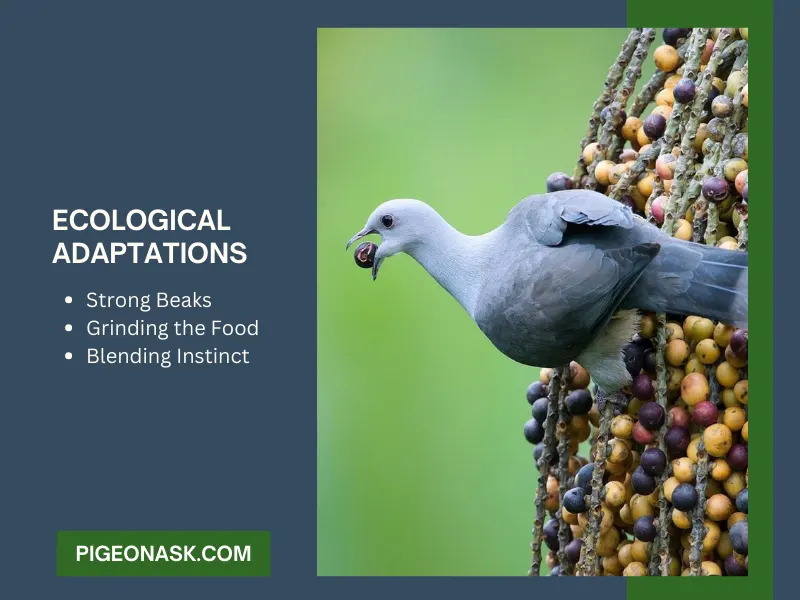
Strong Beaks
As their primary food source is seeds and grains, a weak beak won’t allow them to break open the seeds and grains. That is why these birds have a very strong beak.
Grinding the Food
This is an uncommon behavior pigeon shows to consume food. These birds don’t have any teeth, so they just gulp up their food. But to help with the grinding process, they may also eat small stones or grit.
Blending Instinct
Pigeons that suffer from constant predatorial pressure have developed feathers that allow them to easily blend in with the environment. They can also stay completely idle without making any noise.
This camouflage behavior allows them to avoid the attacks of ravens and owls. Sometimes, they make their nests in a way so that they can easily blend in there, too.
Aggressive and Territorial Habits
While pigeons are very docile and calm, they can showcase quite aggressive and territorial behavior in certain situations.
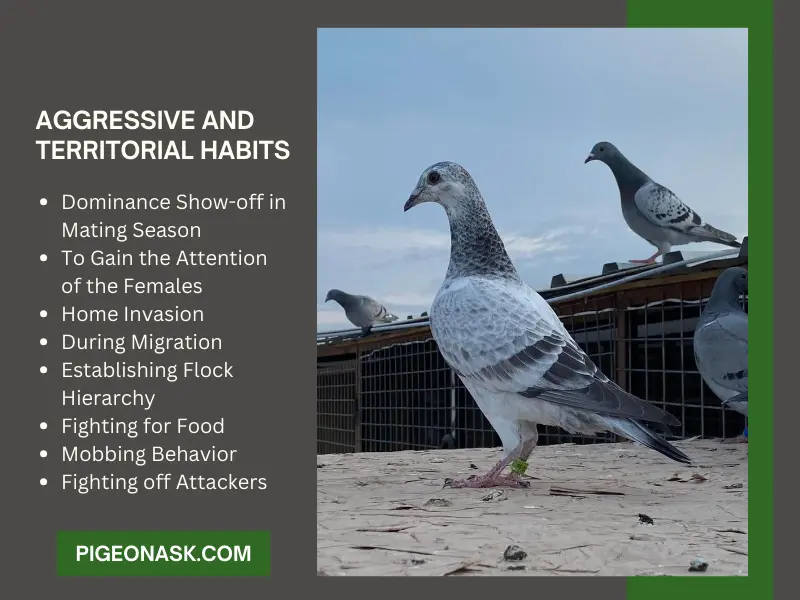
Dominance Show-off in Mating Season
Most of the time, pigeons become aggressive when they are preparing for their mating season. They may show aggressiveness in potential competitions.
During this time, they will also become territorial, and anyone entering their territory can be seen as a potential threat which they might engage with.
To Gain the Attention of the Females
Sometimes, the male birds will show their aggressive nature just to impress the females during courtship.
Home Invasion
You won’t stay calm and composed when someone suddenly invades your home, will you?
The same goes for pigeons. If someone enters their nests, attacks them, or harms the nest in any way, the pigeons will become aggressive.
Pigeons will also become highly territorial around the nest area when they have laid eggs or there are young chicks in the nest.
During Migration
While they are migrating and the flock is settled down somewhere, they don’t want to share their food and resources with other birds and animals. In this scenario, they will become aggressive to anyone that bothers them.
Establishing Flock Hierarchy
In their migratory groups, a flock hierarchy is often established. To show who is commanding who, the pigeons can start to get aggressive with each other.
Fighting for Food
Pigeons become territorial and aggressive if they encounter a location where there is a food shortage and some other bird or pigeon species is feeding there.
Mobbing Behavior
While this is a rare behavior, in some cases, a pack of pigeons will gang up on a target and harass them. The issue can be triggered by territorial invasion or a fight for food.
Fighting off Attackers
When threatened and there is no option to escape, pigeons will start to showcase aggression. Predators like raptors or owls may concern a pigeon enough to be aggressive.
Nesting Behavior
Pigeons are known to show some peculiar behavior when it comes to nesting. Generally, they can nest all year long, but most of the time, they will nest during their mating season.
Both male and female pigeon takes part in nest construction. These nests are made of leaves, twigs, feathers, and grass. In urban areas, you might also see paper and plastic components inside the nests.
These birds are highly protective of their nests and usually pick a spot that is out of the reach of common dangers.
Communication Behavior of Pigeons
When it comes to communication behavior, there are quite a few cues that pigeons use for different scenarios.
First and foremost, you get the regular cooing. This is the most common method of communication among pigeons. There is a distinct cooing pattern based on species.
Cooing duets are performed during courtship. Wing clapping and head bobbing in a rhythm are also part of their communication and mostly indicate excitement. This is also witnessed during courtship.
Pigeons showcase their dominance to the others by puffing up their chest and fanning their tails. This is a sign of dominance and is mostly seen in a flock setting.
Social Behavior
As we mentioned at the beginning of this guide, pigeons are social creatures and like to be grouped with one another most of the time. Some of the most common social behaviors witnessed among pigeons are the following –
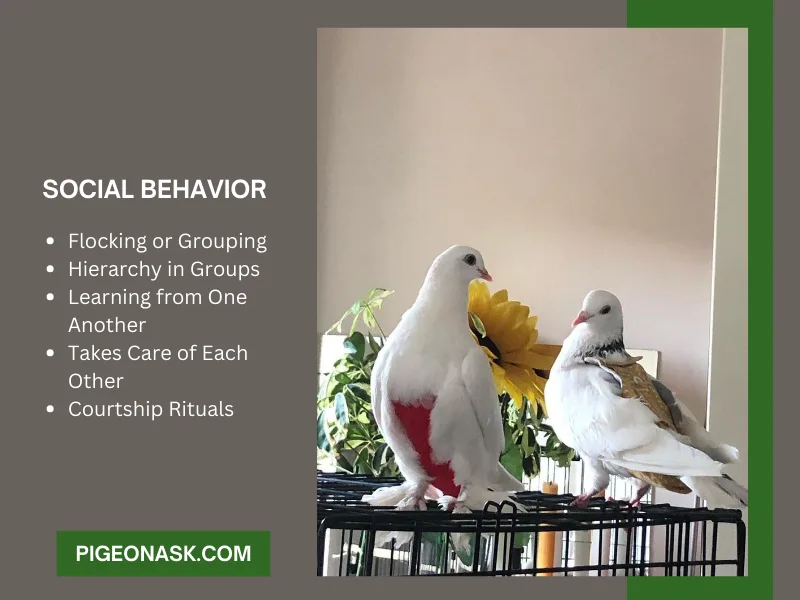
Flocking or Grouping
Pigeons will often form a group or flock to survive. This isn’t much common in the wild, but in most urban areas, that is the case.
The main reason behind this can be related to food or territorial disputes, as these birds will share among their group members but not with an entirely different group.
Hierarchy in Groups
In their established group, pigeons have a pecking order. The ones at the top decide where the group or flock would go for food or migration.
Similar to human society, the dominant pigeons are marked as the leaders while the rest follow their commands.
Learning from One Another
Newborn pigeons in a group often imitate what others in the group are doing and learn from them.
You can find this quite similar to the master and his students, as most of the time, the young ones learn how the leaders pick foraging and migrating places. This way, new leaders are born in the flock and nurtured by the old ones.
Takes Care of Each Other
In a group setting, you will find some pigeons grooming the others. They will also protect one another from danger if the need arrives. This can be seen when raptors or owls attack a flock of pigeons.
Pigeons engage in courtship in order to attract a potential mate. They go through different activities to impress one another and then make the decision to pair up.
Factors that Influence Different Behavioral Habits
Until now, we have discussed the general behavior pattern of pigeons. That being said, there are certain instances where you may seem like a pigeon acting out of the ordinary.
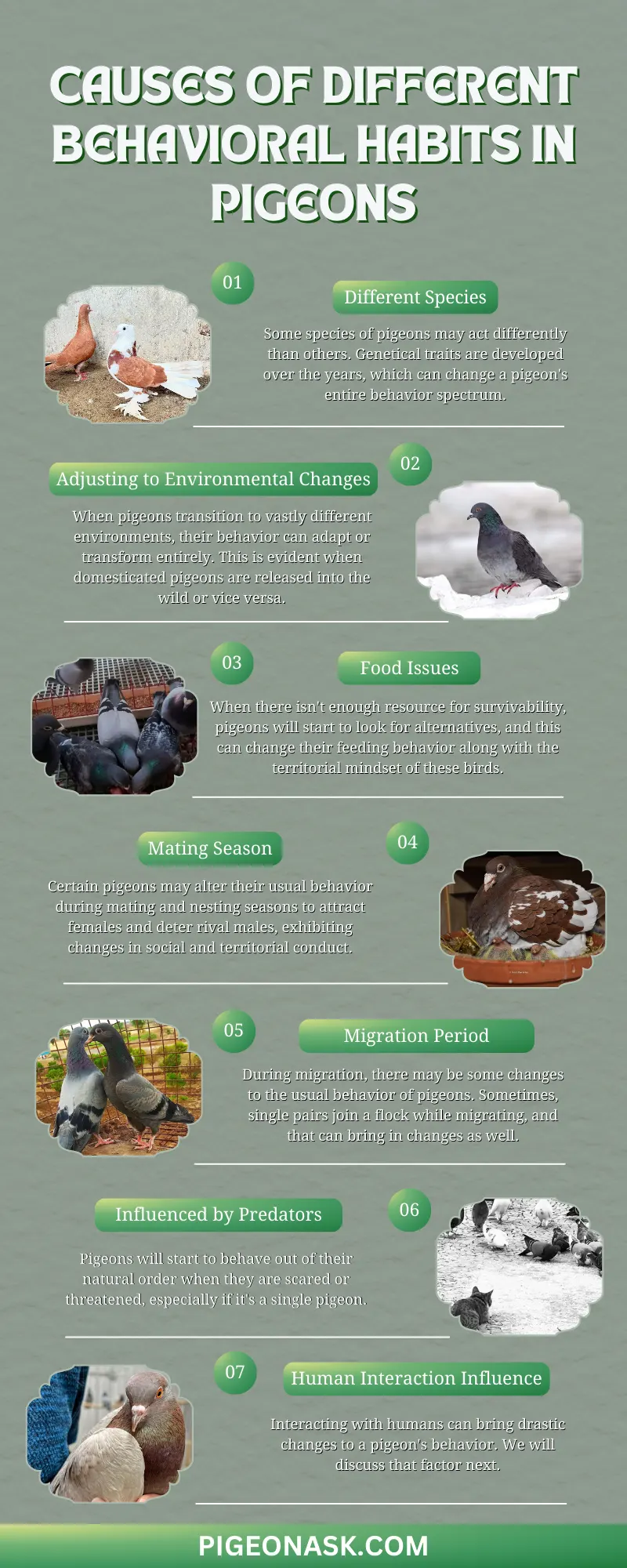
The following suggestions can be the reason why the pigeon is showing such behavioral change –
Different Species
Some species of pigeons may act differently than others. Genetical traits are developed over the years, which can change a pigeon’s entire behavior spectrum.
Adjusting to Environmental Changes
If a pigeon is moved from an environment to a drastically different one, then it may showcase new behavior. They may also change their behavior completely to adjust to the new settings.
This situation is mostly observed when you try to domesticate a wild pigeon. Or take a domesticated pigeon and free it in the wild.
Food Issues
When there isn’t enough resource for survivability, pigeons will start to look for alternatives, and this can change their feeding behavior along with the territorial mindset of these birds.
Mating Season
Some pigeons may show changes in their regular demeanor to impress the female and keep the males away from potential mates. This change is primarily seen in nesting and social and territorial behavior.
Migration Period
During migration, there may be some changes to the usual behavior of pigeons. Sometimes, single pairs join a flock while migrating, and that can bring in changes as well.
Influenced by Predators or Threats
Pigeons will start to behave out of their natural order when they are scared or threatened, especially if it’s a single pigeon.
Human Interaction Influence
Interacting with humans can bring drastic changes to a pigeon’s behavior. We will discuss that factor next.
Human-Induced Factors that Change Pigeon Behavior
When pigeons are raised by humans or get direct help from humans, certain aspects of their behavior will start to change. The most prominent changes noticed are –
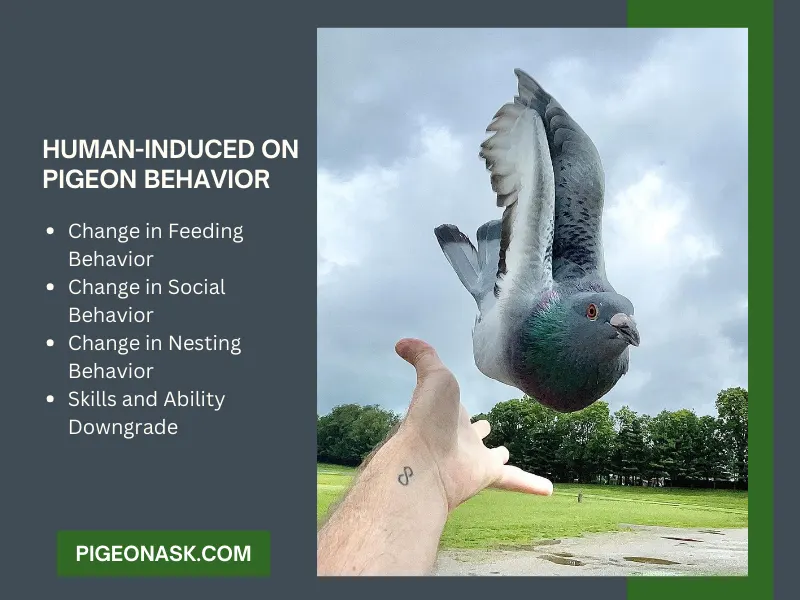
Change in Feeding Behavior
Usually, pigeons will scour an area looking for food. But with human intervention, they don’t have to do that as we feed them if we are raising them. There is an abundance of food for them, so there is nothing to be worried about.
So, these pigeons won’t be desperate to look for food, and this will affect their foraging skills.
Change in Social Behavior
With selective breeding and lone pair-ups. Social behaviors like flocking or courtship aren’t necessary for human protection and are bound to change from the natural order.
Change in Nesting Behavior
Pigeons raised under human care don’t have to make their own home, as their owner will provide them with perfect homes from the get-go. So, the nesting behavior of pigeons also changes.
Skills and Ability Downgrade
Unless the pigeons are bred for athletic purposes, the physical capability of human-raised pigeons is quite a downgrade from a pigeon raised in the wild.
Conservation of Their Behavior
To conserve the natural behavior of wild pigeons, the following steps can be taken –
- Limit the feeding by humans to a minimum amount so that pigeons can search for their food.
- Don’t produce too many pigeon nests; instead, create habitats where pigeons can make their nests and live.
- Protect pigeon-preferred ecology so that they aren’t forced to move to urban birdhouses.
- Reduction in urban litter so that pigeons don’t start to rely on scavenger hunts too much.
- Don’t be too caring and disturb or interrupt the lives of pigeons.
- Giving enough exercise and interaction to pigeons that are raised in farms or other domestic settings.
If you understand the behavioral facts of pigeons, then you will be able to breed and raise them properly. Without following their natural behavior, pigeons may become depressed or unhealthy, which we believe you clearly want to avoid.
So, make sure to understand the bird you’re planning to domesticate before you do it. Best of luck!
And if you want to see more guides and articles like this, then make sure to like & follow us on Facebook, Pinterest & Twitter!
References:
- https://icwdm.org/species/birds/pigeons/pigeon-biology/
- https://www.ncbi.nlm.nih.gov/pmc/articles/PMC6160002/
- https://royalsocietypublishing.org/doi/10.1098/rspb.2012.2893
- https://www.tandfonline.com/doi/pdf/10.1080/00063655609475836
- https://pubmed.ncbi.nlm.nih.gov/930445/
- https://journals.plos.org/plosone/article?id=10.1371/journal.pone.0166572


